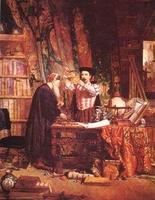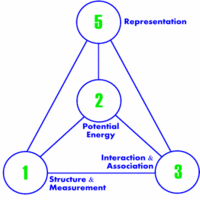| Thursday, February 15, 2007 |
| Patterns and Alchemy |
 First, a little piece about patterns, which I noticed quite randomly in an article about Ancient Chinese Sex Advice: First, a little piece about patterns, which I noticed quite randomly in an article about Ancient Chinese Sex Advice:It is a commonplace that the Han dynasty distinctions between the 100 schools of philosophy are to some extent false divisions forced on a much more complex history. Lewis takes this further and tries to uncover what the categories of thought were in Han and pre-Han China. Part of this, particularly in Writing and Authority, is the importance of patterns. There are patterns that govern the changes in the universe, human affairs and the body, and understanding and adjusting and adjusting to these patterns is what knowledge is all about. (Lewis explains all this a lot better than I do.)That sort of spoke to me. In early times, wise people were those who had integrated all kinds of knowledge, who were skilled in reducing it to simple, universal patterns. And just that idea there, that we even can find patterns in the universe that apply equally well in health, politics, physics, or whatever. Alchemy went out of fashion at some point. Physicists a few hundred years ago, like Newton, were invariably alchemists at the same time. They were kind of inseparable subjects. Da Vinci, he found it quite natural to master art, science and medicine at the same time. If we're looking for the patterns of the universe, it is only logical that we look for the common patterns in all of this. As opposed to separating out one aspect, trying to find the rules for that, and ignoring whether it fits on anything else. It is the difference between holistic thinking, like we associate with Eastern medicine now, and the archetypical Western approach of cutting everything into little pieces and treating them separately. Where, interestingly, the Eastern approach would tend to deal with the exact, unique individual or situation, but as a whole, and the Western approach dissects the pieces, but then treats them in a generalized abstract way, preferably without variation. So, how about alchemy. Wikipedia has a nice page on it: In the history of science, alchemy refers to both an early form of the investigation of nature and an early philosophical and spiritual discipline, both combining elements of chemistry, metallurgy, physics, medicine, astrology, semiotics, mysticism, spiritualism, and art all as parts of one greater force. Alchemy has been practiced in Mesopotamia, Ancient Egypt, Persia, India, and China, in Classical Greece and Rome, in Muslim civilization, and then in Europe up to the 19th century—in a complex network of schools and philosophical systems spanning at least 2500 years.But it doesn't really leave anything that's very applicable nowadays. Are there any alchemists in any meaningful sense nowadays? I mean people who're polymaths who search for the patterns in the universe in both scientific and metaphysical ways? There was Buckminster Fuller. But it is a bit of rare thing. [ History | 2007-02-15 14:24 | 7 comments | PermaLink ] More > |
| Flucidity |
 A.Sorel pointed me to his new TOE (Theory of Everything), Flucidity. I must admit, I wouldn't mind myself coming up with a simple theory that somehow explains phenomena in a great many fields, but I haven't succeeded. Sorel is not a physicist, but he goes in some detail explaining how his theory covers physics as well as economics, personal success, and just about anything else. Despite a couple of attempts, I just don't get the physics part, but looking around on the net, I notice that he gets a relatively promising welcome in physics forums. But as a life tool, I can certainly evaluate it, and it checks out quite well. It is represented in this little diagram there, with these components: A.Sorel pointed me to his new TOE (Theory of Everything), Flucidity. I must admit, I wouldn't mind myself coming up with a simple theory that somehow explains phenomena in a great many fields, but I haven't succeeded. Sorel is not a physicist, but he goes in some detail explaining how his theory covers physics as well as economics, personal success, and just about anything else. Despite a couple of attempts, I just don't get the physics part, but looking around on the net, I notice that he gets a relatively promising welcome in physics forums. But as a life tool, I can certainly evaluate it, and it checks out quite well. It is represented in this little diagram there, with these components:
This approach brings to mind the Law of Attraction, but this is more structured. Let's say there's something you'd like to happen, like, you want to live in a certain type of house. You'd start by making or finding a representation of it, which could be a drawing of it, or a photo, or a magazine. Then you create some structure around it, like, for example, you set up a game for yourself, of going to the kind of neighborhood you'd like to live in once per week, and you set up some rules, which might be completely arbitrary, like that you'll talk with exactly 3 different people in that neighborhood when you go visiting. That sets the stage for interactions, obviously. And all of that creates potential energy, building up some kind of momentum in the direction of your goal. It might bring you closer, and you end up in a new situation, where you might choose a new (better) representation, and go from there, in the same manner. That works, and that's a pretty neat way of structuring it. Picking a representation of what one desires is a well-known tool. Putting a picture of your dream house on your refrigerator door, etc. But putting some structure and some rules around it quickly makes it more real. It has the advantage that one can make it arbitrarily easy, so one doesn't have to get lost in the great difficulty in doing what one wants. One does something more simple around the representation, which creates progress, but which also distracts from worrying about obstacles. The representation and the rules set up a potential. Inevitably one will interact with someone or something in carrying them out, which leads to new opportunities, which only can get one closer to one's aim. So, A+ as a tool for materializing what one wants. Beyond that it makes my head spin if I try to grasp how that applies to physics, or how I can predict anything tangible with it. So, I'll leave it at that for now. [ Patterns | 2007-02-15 14:31 | 7 comments | PermaLink ] More > |